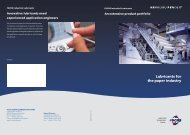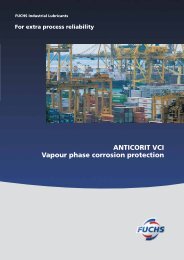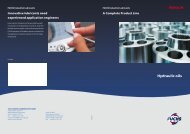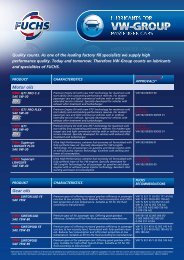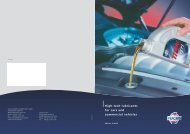R22 Substitution - fuchs europe schmierstoffe gmbh
R22 Substitution - fuchs europe schmierstoffe gmbh
R22 Substitution - fuchs europe schmierstoffe gmbh
Create successful ePaper yourself
Turn your PDF publications into a flip-book with our unique Google optimized e-Paper software.
<strong>R22</strong> <strong>Substitution</strong> – What has to be considered?<br />
Deposit tendency and cleaning effects<br />
Due to their good solvent properties POE-based refrigeration oils can be used to dissolve deposit<br />
and decomposition products of previously used oil/<strong>R22</strong> systems as well as dirt from the plant. The<br />
POE refrigeration oil keeps these pollutions of the plant dispersed in the oil and/or precipitated<br />
in the filter dryer. Optionally, larger dimensioned filters will have to be installed in the suction<br />
channel to allow for the increased amount of flaking particulate materials. Since the cleaning<br />
process of the POE refrigeration oils does not run abruptly, a breakdown of the plant due to a<br />
sudden filter blockade, for instance, is not to be expected.<br />
An oil analysis after approx. 500 to 1000 hours of operation can give information about the portion<br />
of old deposits that can also have negative effects on the heat transfer. If the cleaning effect by<br />
the POE oil completed after the initial operating stage, the permanently positive effect with the<br />
cleanliness of the system will persist in view of the plant efficiency.<br />
If POE oil is used in R422A/R422D/R417A or R507 plants, it increases the thermal capacitance of<br />
the lubricant compared to the mineral-/alkylbenzene oil used in the <strong>R22</strong> cycle. There will be less<br />
conglutination/pigmenting at hot spots, e.g. valve plates, and the lifetime of the oil filling is<br />
extended by the increased thermal stability. The higher acquisition costs for POE refrigeration oil<br />
can be compensated by these extended oil change intervals compared to mineral-/<br />
alkylbenzene oil.<br />
Oil analyses<br />
Oil sample analyses from the plant can document, if the switch from <strong>R22</strong>/mineral oil to HFC/POE<br />
oil can be considered as successful and completed or if further actions are necessary, e.g.<br />
filter/dryer change or oil change. A conclusive oil analysis as to the plant conversion status<br />
comprises the determination of the water content, the remaining mineral oil content (remaining<br />
quantities by mixing remaining quantities of refrigeration oil from the <strong>R22</strong> system in the recharged<br />
POE) and the degree of pollution.<br />
The mineral oil content in POE still contained from the <strong>R22</strong> operation is of particular importance.<br />
With residual mineral oil contents of 4 % maximum, even with low evaporation temperatures of -<br />
35°C and below, a functioning oil transport can be ensured. In case of higher mineral oil<br />
concentrations, oil reefed and heat transfer can be impeded by demixing conditions between<br />
lubricant and refrigerant phase.<br />
16




